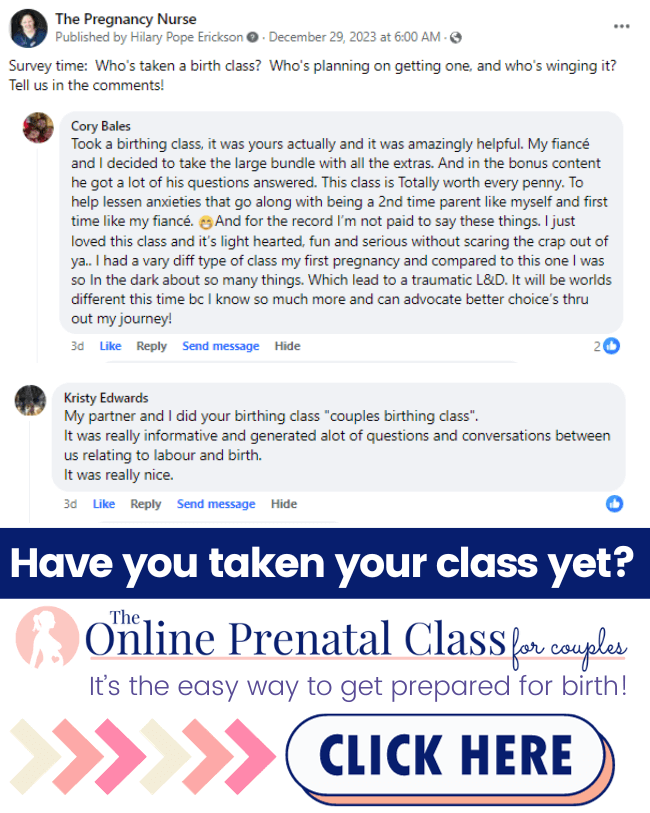👋 I’m so glad YOU are here. Are you looking to also get your partner prepared? This is for BOTH of you. Couples just love it and I know you want to both feel prepared!
Creating a birth plan is a good beginning to starting good communication between the patient and care providers. It is a good idea to include things that are really important to you on your birthing plan. This post will share 10 things that you might want use when you create a “natural” birth plan.
Before we get started, let me share why I’m an authority on birth plans and what to put on them.
Hi, I’m Hilary — The Pregnancy Nurse 👩⚕️. I have been a nurse since 1997 and I have 20 years of OB nursing experience, I am also the curly head behind Pulling Curls and The Online Prenatal Class for Couples. 🩺 I have seen thousands of births — many “natural” and otherwise and I have also seen a LOT of birth plans in my time. I am excited to share what are some options for you to choose between.
Grab my birth plan template right here (plus it comes with a video that explains how to BEST use a birth plan — because I think they’re pretty mis-understood):
First, I want to have a quick chat about what birth plans are, and why I think they’re important.
The most important thing (I think) about a birth plan is that you, and your support person, are thinking about your big day. A written record of your birth wishes. Thinking through these ahead of time puts you YEARS ahead of other birthers.
A few things to know about birth plans:
In no way is it a binding agreement with your birth team that specific things will happen during your delivery. These are just your birth preferences which will shift and adjust as you are in actual labor. Think of it as home plans that end up getting adjusted due to a variety of reasons.
Your birth plan is your OWN birth plan. Just because I have things on here, if you find that aspect of labor isn’t important to you, don’t include it on your special form!
Your birth plan template will need to be adjusted for any medical conditions you have (or end up having) or any medical history that you have. Your medical team will always be thinking about your safety. Some of the items I mention here may NOT be good for you (so ignore them).
Keep an open mind – remember, this is just a PLAN. And we ALL know that plans often get kinks in them. Your open mind is one of the MOST important things you can bring to this natural process!
Healthy mom and healthy baby matter, but you matter too. There are a lot of things we could do to prevent absolutely all risks in maternity service, but they might make your birth less special. So, while those are important, remember your brain and sanity are important too.
This written plan does not take the place of good decision making when the events happen. You may not have a c-section delivery on your plan, but if baby is not looking good, or you end up having severe issues it may likely be your best plan.
Your best choices are made in the moment when you have all the information available. And your healthcare team should honor those choices at that time.
Even if something is on your birth plan I likely circle back and make sure those are still the things you want as labor progresses (because we know minds change).
In here I talk a LOT about flexibility and how important it is. I 100% recommend staying flexible because things will happen on the day that will change your birth plans.
I did a whole podcast on refusing routine things in labor that you might be interested in as well:
Ok, and then before we get into the tips – I want to discuss the words “natural birth”
What is A “Natural Birth”
I find that a lot of people have very different terms for what a “natural birth” is – so, if you were to come into the hospital saying you want a “natural birth” the health care provider really won’t know what you want for your birth experience.
Honestly, it really does mean something different for everyone.
Many people say that a natural birth is birth without medical interventions…. Which could be:
- Less monitoring of the baby
- No medical pain management
- No induction of labor
- Not breaking your water
Some say it’s an “unmedicated birth” … which could be:
- No pain medicine given
- No induction agents given
(But I’ve seen lots of people coming in for an elective induction wanting an “unmedicated birth” – so, you can understand why these terms can be confusing).
I actually have a recent podcast from someone who had a LONG induction, but did it without an epidural:
Keep in mind that some of those options may only be appropriate for low-risk pregnancies. And some of those options can still work for people with issues, like gestational diabetes.
Your desire for natural childbirth is important. However, you are paying for the safety of a hospital. If your desire is for something similar to home births, you may want to consider a home birth instead. As we are contracted to care for you, we have a lot of policies (like the nurse being in the room frequently) that might not be what you want.
Your personal birth plan for a natural delivery allowed the team caring for you to have a better idea of what you want rather than just saying “I have a natural birth plan” so, let’s get into the specifics!
10 Things You Might Want To Put On Your Natural Birth Plan:
Here are a few birth plan examples, and talk about why you may or may not need them. Remember to grab my sample birth plan with my free beginning prenatal class to be able to write these types of things down faster.
Induction only if necessary
If you’re willing to delay baby’s birth until natural labor starts, that is something you would want to discuss with your doctor or midwife in the office. They may offer an elective induction at 39 weeks (meaning it doesn’t have a medical reason) – which you can always refuse.
That all being said, the allure of an elective induction as your due date gets closer, and baby’s head gets lower into the birth canal (and more painful) may be strong. You may change your mind, and want to be induced as you’re in a lot of pain at the end of your pregnancy, and that’s OK too.
Saline Lock IV When Not in Use
While it is 100% possible to give birth in a hospital setting without an IV, your care team will likely find a lot of relief if you have an IV in.
IV’s give us instant access for medication or fluids if something happens. It really allows for much quicker emergency treatment. It might be easy to think we can just put in an IV if an emergency happens, but it can be VERY difficult to get an IV placed if you’re losing a lot of blood, and it does take time. Time that could be really important.
However, it doesn’t always have to be hooked up to fluids all the time.
If an IV is something you’re considered refusing, be sure to talk to your doctor about their medical advice after about 30 weeks of pregnancy. Just so you can be on the same page.
And, as a fellow labor nurse, I really would ask you to consider just having the saline lock in. I explain all of it in this handy video:
Promote maternal movement
Moving during labor can not only help with labor pain – but can also help you to have a vaginal birth.
Telling the staff in your birth plan, and also being willing to move will be a huge help in the progression of your labor. It’s a good thing!
Pro Tip: Get your partner involved in moving you as well! It may seem odd that you wouldn’t be able to move yourself, but it can be more difficult than you think when you are in pain (or end up with an epidural).
Pro Tip #2: Get my birth movement cards with the class to give you some ideas of things to try.
Intermittent monitoring when possible
Most often the hospital will do continuous fetal monitoring, but it is possible to do intermittent monitoring as well. Continuous monitoring is nice because people have eyes on the baby all the time, but intermittent monitoring usually looks like us watching the baby for 20 minutes out of every hour, allowing you to move and walk after those 20 minutes.
Keep in mind that if you are high risk, we may encourage you to monitor baby’s heart rate constantly. Things like this would be an induction, or if you have PIH or an epidural most often require us to either do continuous monitoring, or at least encourage it.
Keep in mind that you can always refuse an intervention in the hospital, but it may have consequences like us stopping the Pitocin (as the nurse’s license is on the line if she gives Pitocin without continuous fetal monitoring).
And yes, I talk MUCH more about fetal monitoring in here.
Mom can eat in labor
Many providers order that patients can only drink “clear liquids” once they are in active labor. Keep in mind, that if that’s what your doctor orders, your labor nurse must adhere to those orders in the delivery room.
Your options would be to bring your own food if you’d still like to eat, or ask your provider to allow you to eat in labor so that you nurse can provide you with their available options.
Before you ignore a doctor’s order, be sure to discuss it with your healthcare team, so that you understand the risks (or benefits) of any choice you’re making!
Promote the golden hour
The golden hours is the first hour after the baby’s birth. Most places encourage you to do skin-to-skin contact with your new baby during that time. And the delivery nurse will postpone most baby care (like the vitamin K shot) until after this first hour.
However, the nurse will be close by in case you need anything and she will also monitor’s baby’s vitals to make sure baby is OK (we can do that as you do skin to skin).
And of course, if you’re wondering more about what happens right after delivery — I have a ton of info in here.
Promote maternal Sleep
You can ask that medical staff keep room visits to a minimum during labor or after delivery. Asking them to promote maternal sleep will help you relax and feel more rested to either have the baby, or before you go home with the baby.
Doula to have access to patient
Many people plan on having a doula. Studies have shown that they can increase your chances of having a vaginal birth.
Ask to be sure that your doula has access to you in the room. While some hospitals prevented doulas from coming into the hospital during the peaks of Covid, most have realized that a trained doula should be allowed in (and most people were allowed to bring them if they got clearance ahead of time). The key was planning ahead and communication (and likely kindness).
Be sure to check out my post on when to hire a doula.
Keep Pain Medication talk to a minimum
Pain relief is important in hospitals, as you can imagine. It is important for us that you understand your pain management options.
However, if you are planning on an unmedicated childbirth (meaning no pain medicine in this instance) you can ask them to not discuss it with you unless you ask. You may have to ask this of every nurse who takes care of you, but they can chart that and then move on.
I would also have a safe word which lets them/your partner know that you are considering medical pain management (and that happens frequently too).
In fact, I go over this entire scenario in the provider communication bonus video in my class.
Keep Baby In the Room in a Cesarean section
If birth takes an unexpected turn and you end up having a cesarean section, you can ask to have the baby stay with you during the rest of the surgery.
Many women find that their hard work of pregnancy is ignored as their birth partner gets all the time with baby while they are in the operating room.
While this can be an important step, some women feel overwhelmed with baby next to them during surgery (once they’re actually doing it) so keep communication lines open between you, your partner and the staff to make sure you feel comfortable as well.
Pro Tip: Learning about a cesarean section (even if you’re not planning on it) is SO important. I have a quick chapter on it in here that SO many people have been grateful for when things didn’t turn out as they’d planned.
Other things you might include:
- Having a water birth (if possible at your desired location).
- Specifying who your support team is (you might have a mom or sister coming who is important to you) – and possibly their contact information.
- No use of forceps or a vacuum
- First baby bath being delayed.
- Delayed cord clamping, in recent years, it has been the standard of care to not clamp the umbilical cord for the first 30-60 seconds of life.
Things YOU Can Do to Support a Natural Birth
While there is a lot to put on your birth plan, there is a lot YOU can do to promote a natural birth as well.
Try to labor at home longer. Early labor where the contractions are less frequent or painful, should be done at home. As you progress into active labor, you can consider coming into the hospital.
Put things in your hospital bag that help promote your plan. Be it food, distractions, massage items (I talk about using a racquet ball in my classes). I talk about a lot of things you can use in my class beyond just those. I also have some good tips for using a labor ball too!
Learn some breathing techniques. I think most moms who are successful at having their “natural birth” have done a lot of preparation ahead of time, so that it isn’t the first time they are trying things when they get to the hospital.
And yes, I talk a LOT about all these things in my class.
Sharing Your Delivery preferences
I would possibly ask for your OB-GYN or midwife’s help making your birth plan along the way. It shows that you’re looking for their guidance and it also communicates to them what you want early on.
Once you’re at the hospital — a good way of starting your provider communication off is sharing a birth plan. However, expectant parents should continue that communication throughout their hospital stay.
Don’t be afraid to change your mind, or decide you want something different. No one minds, or cares — and NO ONE “holds” you to that birth plan!
Staying Positive and Flexible
One of the biggest mistakes I see is families who focus some much on NOT having specific things (like epidurals, cesareans, inductions, etc) in their birth.
But, staying positive is SO important. I am a big fan of positive affirmations — I even have a little printable one I can send you:
The birth of your baby is an important change in your life, and hopefully you have an amazing birth story, and have plans about what you might change next time.
Clearly, having a”natural” birth is important to YOU. I’d love to help you get the confident hospital birth you’re looking for. The Online Prenatal Class for Couples includes:
- Breathing techniques and practice to help relax you.
- Tips and household items you and your partner can use to take away the pain.
- Can be done in just about 3 hours.
- Comes at 3 price points for all the budgets.
I’d love to see you inside. Check out the class here.
But, if you’re not QUITE ready for the full thing, don’t forget to grab my free birth prep kit — your first step in preparation for your confident birth.








 34 Weeks Pregnant: What are the symptoms of preterm labor?
34 Weeks Pregnant: What are the symptoms of preterm labor?
